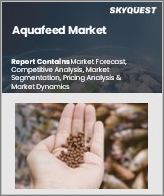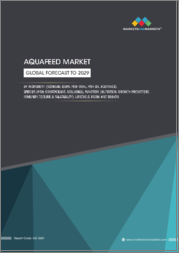
|
시장보고서
상품코드
1577296
수산 사료 및 수산양식 첨가제 시장, 기회, 성장 촉진요인, 산업 동향 분석과 예측(2024-2032년)Aquafeed and Aquaculture Additives Market, Opportunity, Growth Drivers, Industry Trend Analysis and Forecast, 2024-2032 |
||||||
세계의 수산 사료 및 수산양식 첨가제 시장은 지속가능한 수산물의 수요 증가와 수산양식 기술의 진보에 의해 촉진되며, 2024-2032년 4.2%의 CAGR을 기록합니다.
현재 추세는 환경에 미치는 영향을 줄이면서 어류의 성장과 건강을 촉진하는 고품질의 영양학적으로 최적화된 사료 배합으로 전환하는 것을 강조하고 있습니다. 프로바이오틱스, 프리바이오틱스, 에센셜 오일 등 사료 효율을 높이고 질병 저항성을 향상시키는 천연 첨가제 및 기능성 첨가제에 대한 관심이 높아지고 있습니다.
원재료 가격의 변동은 큰 관심사입니다. 어분이나 콩과 같은 원자재 비용의 변동은 전체 사료 비용과 수익성에 영향을 미칠 수 있습니다. 또한 규제 조치와 남획 우려로 인해 어획량이 제한되어 어분 생산에 직접적인 영향을 미치고 이 중요한 원료의 가용성이 제한되고 있습니다. 이러한 제약은 가격을 상승시키고, 대체 사료 원료를 개발해야 하며, 사료 배합 전략에 영향을 미쳐 양식 사업의 운영 비용을 증가시킬 수 있습니다.
아미노산 부문은 5억 1,280만 달러를 창출하고 예측 기간 중 5.2%의 연평균 복합 성장률(CAGR)로 성장할 것으로 예상됩니다. 아미노산은 어류의 건강을 강화하고 성장을 가속하는 데 중요한 역할을 하므로 수산 사료 및 수산양식 첨가제 시장을 장악하고 있습니다. 단백질 합성에 필수적인 아미노산은 수생 생물의 발달과 건강에 필수적입니다. 수산 사료에 포함되면 아미노산은 사료 효율을 높이고 다양한 어류와 새우 종의 영양 요구를 충족시킬 수 있습니다. 이 부문의 우위는 고품질 해산물에 대한 수요 증가와 지속가능한 양식업 관행에 대한 노력으로 강화되고 있습니다. 아미노산은 사료 요구율을 향상시키고 항생제의 필요성을 감소시킵니다.
2023년 수산 사료 및 수산양식 첨가제 산업에서 연어 부문이 66%의 점유율을 차지할 것으로 예상됩니다. 수산 사료 및 수산양식 첨가제 시장은 최종 용도별로 역동적으로 세분화되어 다양한 수생 생물 종의 고유한 요구를 충족시키고 있습니다. 연어와 틸라피아는 성장률과 사료 효율을 높이는 특수 사료에 대한 강력한 수요에 힘입어 지배적인 부문으로 부상하고 있습니다. 마찬가지로 메기와 잉어 역시 건강 및 성능 향상을 위한 맞춤형 사료 솔루션이 제공되고 있습니다.
아시아태평양의 수산 사료 및 수산양식 첨가제 시장은 자원의 가용성, 비용 효율적인 노동력, 양식을 위한 양호한 환경 조건에 힘입어 2024-2032년 4.5%의 성장률을 나타낼 것으로 예상됩니다. 양식 기술의 발전은 1인당 수산물 소비량 증가와 함께 이 지역의 수산업을 확대할 것으로 보입니다. 또한 노동 인구 증가, 소득 수준 상승, 단백질이 풍부한 식단에 대한 인식이 높아지면서 아시아태평양의 수산물 가공품에 대한 수요가 증가할 것으로 예상됩니다.
목차
제1장 조사 방법과 조사 범위
제2장 개요
제3장 업계 인사이트
- 에코시스템 분석
- 주요 제조업체
- 유통업체
- 업계 전체의 이익률
- 업계에 대한 영향요인
- 촉진요인
- 수산 사료 수출의 증가가 북미 시장의 성장을 지원한다.
- 호황을 보이는 수산물 무역이 어류와 양식의 수요를 촉진한다.
- 어류 양식 동향의 증가
- 페루에서 어분 생산의 증가
- 시장이 해결해야 할 과제
- 원료 가격의 변동
- 어분 생산에 영향을 미치는 어획 제한
- 시장 기회
- 새로운 기회
- 성장 가능성 분석
- 촉진요인
- 원재료 상황
- 제조 동향
- 기술의 진화
- 지속가능 제조
- 그린 프랙티스
- 탈탄소화
- 지속가능 제조
- 원재료의 지속가능성
- 가격 동향(달러/톤), 2021-2032년
- 규제와 시장에 대한 영향
- Porter의 산업 분석
- PESTEL 분석
제4장 경쟁 구도
- 기업 점유율 분석
- 경쟁 포지셔닝 매트릭스
- 전략 전망 매트릭스
제5장 시장 규모·예측 : 제품별, 2021-2032년
- 주요 동향
- 아미노산
- 항생제
- 비타민
- 사료용 산미료
- 기타
제6장 시장 규모·예측 : 최종 용도별, 2021-2032년
- 주요 동향
- 갑각류
- 연체동물
- 잉어
- 연어
- 메기
- 틸라피아
- 기타
제7장 시장 규모·예측 : 지역별, 2021-2032년
- 주요 동향
- 북미
- 미국
- 캐나다
- 유럽
- 독일
- 영국
- 프랑스
- 이탈리아
- 스페인
- 기타 유럽
- 아시아태평양
- 중국
- 인도
- 일본
- 한국
- 호주
- 기타 아시아태평양
- 라틴아메리카
- 브라질
- 멕시코
- 아르헨티나
- 기타 라틴아메리카
- 중동 및 아프리카
- 사우디아라비아
- UAE
- 남아프리카공화국
- 기타 중동 및 아프리카
제8장 기업 개요
- Basf SE
- Biomar
- Alltech
- DSM
- BASF
- Ridley
- Evonik
- Cargill Inc
- Beneo GmbH
- Novus International
The Global Aquafeed and Aquaculture Additives Market will witness a 4.2% CAGR from 2024 to 2032, driven by the rising demand for sustainable seafood and advancements in aquaculture technology. Current trends highlight a shift towards high-quality, nutritionally optimized feed formulations that promote fish growth and health while reducing environmental impact. There's an increasing focus on natural and functional additives, such as probiotics, prebiotics, and essential oils, which enhance feed efficiency and improve disease resistance.
Fluctuations in raw material prices pose a major concern. Volatility in the cost of ingredients like fishmeal and soy can impact overall feed costs and profitability. Additionally, regulatory measures and concerns over overfishing have led to restrictions on fish catches, directly affecting fish meal production and limiting the availability of this crucial ingredient. These constraints can drive up prices and necessitate the development of alternative feed ingredients, influencing feed formulation strategies and potentially increasing operational costs for aquaculture businesses.
The Aquafeed and Aquaculture Additives Industry is sorted based on end use , product, and region.
The amino acids segment is projected to generate USD 512.8 million and grow at a 5.2% CAGR during the forecast period. Amino acids dominate the aquafeed and aquaculture additives market due to their crucial role in enhancing fish health and promoting growth. Essential for protein synthesis, they are vital for the development and well-being of aquatic species. When incorporated into aquafeed, amino acids boost feed efficiency and meet the nutritional needs of various fish and shrimp species. The segment's dominance is strengthened by the rising demand for high-quality seafood and a commitment to sustainable aquaculture practices. Amino acids improve feed conversion ratios and reduce the need for antibiotics, aligning with the industry's shift towards healthier solutions.
The salmon segment held a commanding 66% share of the aquafeed and aquaculture additives industry in 2023. The aquafeed and aquaculture additives market segments dynamically by end use , addressing the unique needs of various aquatic species. Salmon and tilapia emerge as dominant segments, fueled by a strong demand for specialized feeds that enhance growth rates and feed efficiency. Likewise, catfish and carp receive customized feed solutions aimed at improving their health and performance.
Asia Pacific aquafeed and aquaculture additives market will show a 4.5% growth rate during 2024-2032, bolstered by the availability of resources, cost-effective labor, and favorable environmental conditions for aquaculture. Technological advancements in cultivation, coupled with rising per-capita consumption of aquatic products, are set to expand the region's fishery industry. Moreover, a growing working population, rising income levels, and heightened awareness of protein-rich diets are expected to boost the demand for processed seafood products in the Asia Pacific.
Table of Contents
Chapter 1 Methodology and Scope
- 1.1 Market scope and definition
- 1.2 Base estimates and calculations
- 1.3 Forecast calculation
- 1.4 Data sources
- 1.4.1 Primary
- 1.4.2 Secondary
- 1.4.2.1 Paid sources
- 1.4.2.2 Public sources
Chapter 2 Executive Summary
- 2.1 Industry 360° synopsis
Chapter 3 Industry Insights
- 3.1 Industry ecosystem analysis
- 3.1.1 Key manufacturers
- 3.1.2 Distributors
- 3.1.3 Profit margins across the industry
- 3.2 Industry impact forces
- 3.2.1 Growth drivers
- 3.2.1.1 Rising export of aquafeed will support the market growth in North America
- 3.2.1.2 Booming seafood trade propelling the demand for fish and aquaculture
- 3.2.1.3 Increase in fish farming trends
- 3.2.1.4 Growing fish meal production in Peru
- 3.2.2 Market challenges
- 3.2.2.1 Fluctuations in raw material prices
- 3.2.2.2 Restrictions on fish catches affecting fish meal production
- 3.2.3 Market opportunity
- 3.2.3.1 New opportunities
- 3.2.3.2 Growth potential analysis
- 3.2.1 Growth drivers
- 3.3 Raw material landscape
- 3.3.1 Manufacturing trends
- 3.3.2 Technology evolution
- 3.3.2.1 Sustainable manufacturing
- 3.3.2.1.1 Green practices
- 3.3.2.1.2 Decarbonization
- 3.3.2.1 Sustainable manufacturing
- 3.3.3 Sustainability in raw materials
- 3.3.4 Pricing trends (USD/Ton), 2021 - 2032
- 3.3.4.1 North America
- 3.3.4.2 Europe
- 3.3.4.3 Asia Pacific
- 3.3.4.4 Latin America
- 3.3.4.5 Middle East and Africa
- 3.4 Regulations and market impact
- 3.5 Porter's analysis
- 3.6 PESTEL analysis
Chapter 4 Competitive Landscape, 2023
- 4.1 Company market share analysis
- 4.2 Competitive positioning matrix
- 4.3 Strategic outlook matrix
Chapter 5 Market Size and Forecast, By Product, 2021-2032 (USD Million, kilo Tons)
- 5.1 Key trends
- 5.2 Amino acids
- 5.3 Antibiotics
- 5.4 Vitamins
- 5.5 Feed acidifiers
- 5.6 Others
Chapter 6 Market Size and Forecast, By End Use, 2021-2032 (USD Million, Kilo Tons)
- 6.1 Key trends
- 6.2 Crustaceans
- 6.3 Mollusks
- 6.4 Carp
- 6.5 Salmon
- 6.6 Catfish
- 6.7 Tilapia
- 6.8 Others
Chapter 7 Market Size and Forecast, By Region, 2021-2032 (USD Million, Kilo Tons)
- 7.1 Key trends
- 7.2 North America
- 7.2.1 U.S.
- 7.2.2 Canada
- 7.3 Europe
- 7.3.1 Germany
- 7.3.2 UK
- 7.3.3 France
- 7.3.4 Italy
- 7.3.5 Spain
- 7.3.6 Rest of Europe
- 7.4 Asia Pacific
- 7.4.1 China
- 7.4.2 India
- 7.4.3 Japan
- 7.4.4 South Korea
- 7.4.5 Australia
- 7.4.6 Rest of Asia Pacific
- 7.5 Latin America
- 7.5.1 Brazil
- 7.5.2 Mexico
- 7.5.3 Argentina
- 7.5.4 Rest of Latin America
- 7.6 MEA
- 7.6.1 Saudi Arabia
- 7.6.2 UAE
- 7.6.3 South Africa
- 7.6.4 Rest of MEA
Chapter 8 Company Profiles
- 8.1 Basf SE
- 8.2 Biomar
- 8.3 Alltech
- 8.4 DSM
- 8.5 BASF
- 8.6 Ridley
- 8.7 Evonik
- 8.8 Cargill Inc
- 8.9 Beneo GmbH
- 8.10 Novus International



















